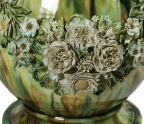
– George Clinton (1975)1
Funk is more than attitude. It’s about rhythm, finding the groove, and getting down. A musician locked in on a bass, tearing through a riff, gets down as people dance and gyrate to the pulsating beat of the music. Yeah, that’s the funk. Open the space up a little. Move and groove. Make it a little edgy.
Take that sense of playful exploration and break-the-rules adventure into the world of ceramics and what do you get? An intriguing exhibit entitled Funk You Too! Humor and Irreverence in Ceramic Sculpture, at the Museum of Art and Design (MAD). The show, curated by Puerto Rican/Miami native Angelik Vizcarrondo-Laboy, presents a variety of figurative ceramics born out of, or inspired by, sensibilities of the California Funk Art movement during the 1960s.
One contextual challenge for the exhibit is that art tends to be elevated, revered, and literally put on a pedestal in a museum context. The irony is that many of the artists associated with early funk in California were thumbing their noses at the traditional art establishment, making fun of themselves or each other.2 At a time when abstract expressionism (1981) literally shows he was full of shit. But true to form, it was colorful shit. And that’s what sold. Break the rules. Do the unexpected. Be smart about it. Offer up the ‘shock of the new’ served with a little tongue in cheek humor.3 How serious can viewers be when the artist is being a pisser? The contradiction is hilarious. Fortunately, for those who do not share those sensibilities, the show is not all guffaws.






